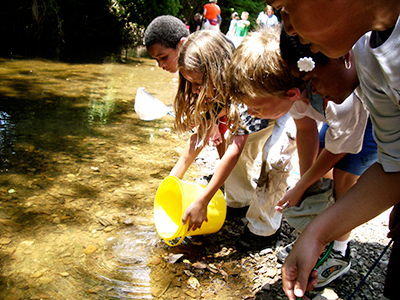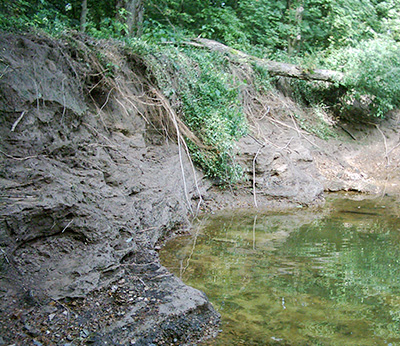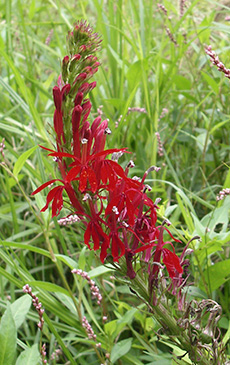Creek Restoration

The property at the Litzsinger Road Ecology Center (LREC), includes about a half-mile segment of Deer Creek. Most of the stream banks at LREC border our woodland habitat. The woodland helps the stream by providing shade to protect it from overheating in the summer, by reducing the erosion of the stream banks, and by providing brush and snags that fish and aquatic invertebrates use for habitat.
Restoration of the stream habitats in Deer Creek is perhaps our greatest challenge. This stems from the fact that, while we have a great degree of control over our own property, we have very little control over the water that comes down the creek and the things the water carries. During a strong thunderstorm in the area, the intense rainfall can drop a tremendous amount of water on paved surfaces. This water drains quickly into the stormwater system and then rapidly flow into the creek. After a good downpour, in less than an hour Deer Creek may rise to eight feet deep. This amount of water has the potential to pull large amounts of soil from the stream banks and even to move large rocks along the stream bed.

The majority of our stream restoration efforts have focused on planting native vegetation on the stream banks to reduce bank erosion. These efforts are focused on areas that are not currently actively eroding since in areas with active erosion, there is little we can do that would stand up to the intense forces that are exerted by the stream during flood events. To successfully establish vegetation on the banks, we have seeded native grasses and forbs like creek oats, cardinal flower, and horsemint along with planting bare-root tree and shrub seedlings such as buttonbush, ninebark, and river birch.

Besides the erosive forces, stream restoration efforts face the challenge of a continual supply of litter. Even following small storm events, we frequently find trash ranging from plastic bags and drink containers to balls, tires, and bits of discarded lumber. Following the intense flooding caused by the remnants of Hurricane Ike in September of 2008, we found a port-a-potty and a full 55-gallon drum of a chemical sealant on site. Elsewhere along Deer Creek following that storm, there were full pallets of lumber, dozens more of the 55-gallon chemical drums, and at least two small boats that had been washed downstream! Besides being an eyesore, the litter can also have health effects on wildlife that might ingest it. Several times each year, we walk the stream and remove as much of the litter as we can.

A third restoration challenge in and along Deer Creek is invasive species. Seeds of many of the more aggressive invasive species are carried readily by water. These include Japanese hops, Johnson grass, and lesser celandine.
Despite the challenges listed above and being located in the middle of a suburban area, Deer Creek supports a diverse array of aquatic life. Researchers have identified seven species of fish in Deer Creek at LREC. Staff regularly see several species of turtle basking near the large pools. A diverse array of aquatic insects and other invertebrates are found in the stream as well. See our Research Studies for further details.